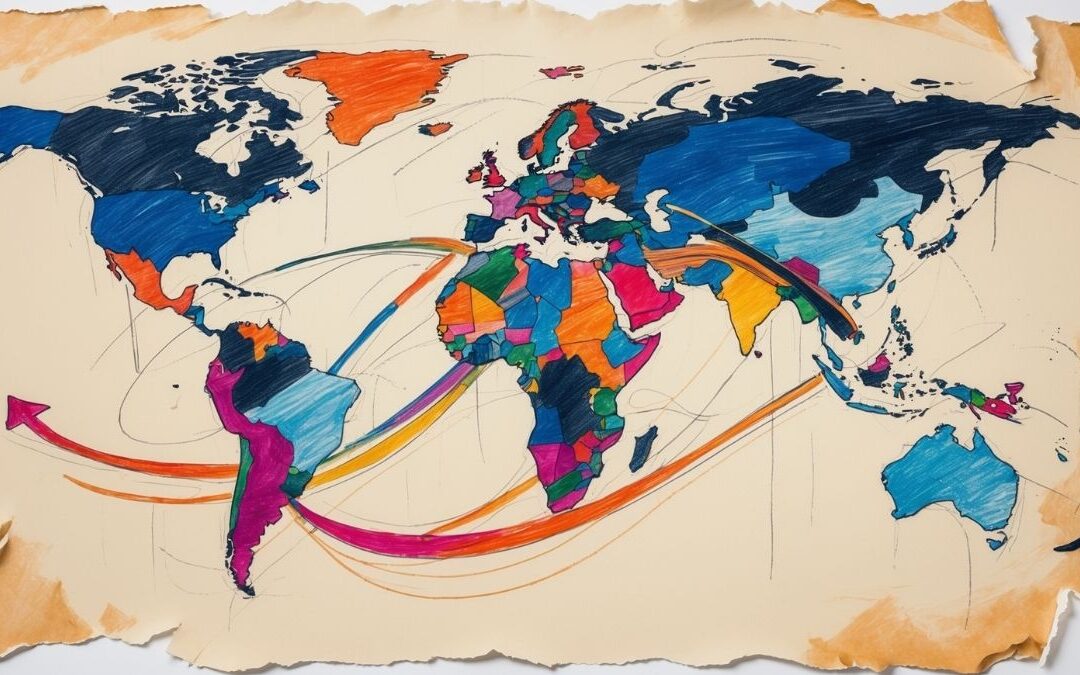- Podcast Episode
- Daily Expression | Burst Your Bubble
- Daily Question | When Have You Felt Most Truly Alive, and What Did That Experience Teach You?
- Daily What If | What If We Could Communicate with Aliens?
- Word of the Day | Valorous
- Weekly History Bites | The Construction of the Great Pyramids: Engineering Marvels of Ancient Egypt
- Weekly Myths and Legends | The Native American Legend of the Corn Spirit: Harvest and Renewal
Podcast Episode
Daily Expression | Burst Your Bubble

Have you ever been super excited about something, maybe you just aced a test, or you’re dreaming about a fantastic vacation, and then someone comes along and says something that just completely deflates your enthusiasm? Like a balloon suddenly losing all its air? Well, that feeling is often described by the expression: “burst your bubble.”
Isn’t it a funny image? A delicate, shimmering bubble of joy or optimism, and then – pop! – it’s gone, replaced by a less exciting reality.
So, what does it really mean to “burst someone’s bubble”? Essentially, it means to shatter someone’s illusion, their happy belief, or their optimistic view of a situation by introducing a harsh or unpleasant truth. It’s often done unintentionally, but sometimes it can be a deliberate act.
Where does this bubbly expression come from? The imagery is pretty clear. Bubbles are fragile and easily broken. They represent something delicate and often temporary, much like a naive or overly optimistic belief. The act of bursting the bubble signifies the sudden and often unwelcome intrusion of reality.
Think about some common scenarios where you might hear this expression. Imagine a child who’s convinced they’re going to get a pony for their birthday, and a parent gently explains that it’s just not possible. That parent is, in a way, bursting the child’s bubble.
Or picture a group of friends excitedly planning an outdoor picnic, only for someone to point out that the weather forecast predicts heavy rain. That friend might be seen as bursting their bubble, even though they’re just being practical.
We’ve probably all been on both sides of this expression. We’ve had our bubbles burst, and we’ve likely been the one holding the metaphorical pin at some point, maybe without even realizing it.
But is bursting someone’s bubble always a bad thing? Not necessarily. Sometimes, a dose of reality is exactly what’s needed, even if it’s initially disappointing. For instance, if someone has an unrealistic business plan, a friend who points out the potential pitfalls might be seen as bursting their bubble, but they could also be saving them from significant heartache and financial loss down the line.
The intention behind bursting the bubble often plays a big role in how it’s received. If it’s done with kindness and a genuine concern for the other person’s well-being, it might be more easily accepted. However, if it’s done out of negativity, jealousy, or a desire to be superior, it can feel hurtful and dismissive.
The power of this expression lies in its ability to capture a complex emotional experience in just a few words. We all understand the feeling of having our hopes or illusions suddenly shattered.
But let’s think deeper about what this expression really means in our lives. I think it touches on the delicate balance between optimism and realism. While it’s important to have dreams and be hopeful, it’s also crucial to have a grounding in reality. Sometimes, those two things can clash.
Consider the role of “bubble bursters” in society. Are they the necessary voices of reason, preventing us from getting carried away with unrealistic expectations? Or are they just negative people who try to dampen everyone else’s spirits? It probably depends on the situation and the way it’s done.
And what about our own bubbles? Are there times when we cling to illusions that are ultimately harmful to us? Maybe we’re in a toxic relationship but refuse to see the red flags, or perhaps we’re pursuing a goal that’s simply not achievable. In those cases, maybe a little bubble-bursting from ourselves or from someone we trust could be beneficial in the long run.
Here’s a thought to ponder: What if we learned to gently deflate bubbles rather than bursting them abruptly? What if we could offer a more nuanced perspective without completely shattering someone’s enthusiasm?
Maybe it’s about timing, or about the way we deliver the information. Instead of saying “That’s impossible,” perhaps we could say, “That’s a really ambitious goal. What steps have you considered to overcome some of the potential challenges?”
What if we also learned to build stronger, more resilient bubbles? Bubbles that can withstand a little bit of wind and rain, so to speak. Maybe that comes from having a healthy dose of self-awareness and a realistic understanding of the world, while still allowing ourselves to dream and be optimistic.
So, the next time you feel the urge to burst someone’s bubble, or you feel your own bubble about to pop, take a moment to consider the situation. Is this a necessary dose of reality, or is it just unnecessary negativity? Is there a gentler way to approach this? And how can we build our own resilience so that the inevitable bumps in the road don’t completely deflate us?
Now, I’d love to hear your thoughts on this. What if we could create a world where we could offer realistic perspectives with kindness and empathy, without completely bursting each other’s bubbles? Share your experiences and insights with us in the comments section on the podcast, on our website englishpluspodcast.com, or on our Patreon page.
And my friends, if you enjoy these short episode from English Plus, you will love our longer episodes, audio series and courses on English Plus Podcast, so to find out our latest content, head over to englishpluspodcast.com and while at it, consider unlocking access to everything English Plus Podcast has to offer by subscribing on Apple Podcasts or Patreon. Thank you for listening, I will see again soon with another intriguing short from English Plus Podcast.
To unlock full access to all our episodes, consider becoming a premium subscriber on Apple Podcasts or Patreon. And don’t forget to visit englishpluspodcast.com for even more content, including articles, in-depth studies, and our brand-new audio series now available in our English Plus Podcast’s shop!
Daily Question | When Have You Felt Most Truly Alive, and What Did That Experience Teach You?

Let’s dive into a question that might stir some deep emotions and memories: When have you felt most truly alive? And what did that experience teach you?
Think about it. What does it even mean to feel truly alive? It’s more than just being physically present. It’s that feeling of intense engagement with life, a sense of vibrancy, connection, and maybe even a little bit of awe. It’s when your senses are heightened, your emotions are strong, and you feel completely immersed in the moment.
Maybe it was a breathtaking experience in nature, like witnessing a stunning sunset, hiking to the top of a mountain, or swimming in a crystal-clear ocean. Perhaps it was a moment of intense connection with another person, like sharing a deep conversation, falling in love, or celebrating a significant milestone together. Or maybe it was a moment of personal triumph, like achieving a long-sought-after goal, overcoming a major challenge, or expressing your creativity in a meaningful way.
For some, feeling truly alive might come from moments of intense excitement or adventure, like riding a rollercoaster, traveling to a new and exotic place, or performing on stage. For others, it might be found in quieter moments of profound peace and contentment, like meditating in nature, spending quality time with loved ones, or simply savoring a cup of coffee on a quiet morning.
The experience of feeling truly alive is deeply personal and can vary greatly from one person to another. What makes one person feel exhilarated might feel overwhelming to someone else.
But I think there are some common threads that run through these moments. Often, they involve a sense of presence, of being fully engaged in the here and now, without distractions or worries about the past or the future. They often involve a connection to something larger than ourselves, whether it’s nature, other people, or a sense of purpose. And they often evoke strong positive emotions like joy, gratitude, love, or awe.
Now, think back to a time in your life when you felt that intense sense of being truly alive. What were you doing? Who were you with? What were the circumstances? Try to recall the details, the sensations, the emotions you felt.
What was it about that particular experience that made you feel so alive? Was it the challenge you overcame? The beauty you witnessed? The connection you shared? The sense of freedom or accomplishment?
And perhaps even more importantly, what did that experience teach you? What insights did you gain about yourself, about life, or about what truly matters to you?
Maybe it taught you the importance of taking risks and stepping outside of your comfort zone. Perhaps it showed you the power of human connection and the joy of sharing experiences with others. Or maybe it revealed a hidden strength or passion within yourself that you weren’t aware of before.
Sometimes, these moments of feeling truly alive can serve as important guideposts in our lives, reminding us of what brings us joy, what we value most, and what kind of experiences we want to seek out more often.
What if we consciously tried to incorporate more of the elements from those “alive” moments into our daily lives? If it was the connection with nature, maybe we could spend more time outdoors. If it was the feeling of accomplishment, maybe we could set more challenging but achievable goals. If it was the joy of creativity, maybe we could dedicate more time to our hobbies and passions.
It’s not always possible to replicate those exact moments, but we can often find ways to bring more of that same energy and vibrancy into our everyday routines. It might be as simple as practicing mindfulness, savoring small pleasures, or consciously connecting with the people around us.
Consider the contrast. Are there times when you feel the opposite of alive – perhaps feeling numb, disconnected, or just going through the motions? What are the factors that contribute to those feelings? And how might you counteract them by bringing more “aliveness” into your day?
Maybe reflecting on those moments when we felt most alive can help us identify what truly nourishes our souls and what we need to prioritize in order to live a more meaningful and fulfilling life.
What if the key to feeling more alive isn’t about grand adventures or extreme experiences, but about cultivating a sense of wonder and appreciation for the small moments of beauty and connection that happen all around us every day?
I’d love to hear your thoughts on this. When is a time you felt most truly alive, and what is one key takeaway from that experience that you can apply to your life today? Share your stories and reflections with us in the comments section on the podcast, on our website englishpluspodcast.com, or on our Patreon page.
Daily What If | What If We Could Communicate with Aliens?

Buckle up, because today we’re going on an interstellar thought experiment. What if, suddenly, we found a way to communicate with aliens? Not just a fleeting signal, but a real, two-way conversation with intelligent life from another planet.
Think about the sheer magnitude of that moment. It would be arguably the most significant discovery in human history, completely reshaping our understanding of the universe and our place within it.
But what would that communication even look like? Would they speak a language we could understand? Would we need some kind of universal translator, like in science fiction movies? Or would we start with something more fundamental, like mathematics or visual symbols?
Imagine the initial attempts at making contact. Would it be a moment of excitement and wonder, or would there be fear and uncertainty? How would our governments and societies react to the news? It would undoubtedly be a global event, capturing the attention of everyone on Earth.
What would we even say to them? What would be our first message to an alien civilization? Would we introduce ourselves and our planet? Would we ask about their history, their technology, their culture? The possibilities are endless, and the pressure to make a good first impression would be immense.
And what would we want to know from them? Would we seek answers to some of humanity’s biggest questions, like the origin of life or the secrets of the universe? Would we ask for their help in solving global challenges like climate change or disease? Or would we be cautious, wary of their intentions?
The potential for learning and growth could be staggering. Imagine the knowledge and perspectives an alien civilization might offer. They could have completely different ways of thinking, solving problems, and organizing their societies. We might learn about technologies we haven’t even dreamed of, or gain new insights into the fundamental laws of nature.
But there could also be challenges. What if their understanding of ethics, morality, or even basic concepts like time and space is completely different from ours? Misunderstandings could easily arise, even with the best of intentions.
And what if their civilization is far more advanced than ours? Would we be in awe, or would we feel insignificant? Would they be benevolent and willing to share their knowledge, or might they see us as primitive or even a threat?
The sheer diversity of life that could exist in the universe is mind-boggling. Imagine the different forms these aliens might take. Would they be humanoid like us, or something completely beyond our comprehension? Would they even be carbon-based life forms?
Communicating with beings so different from us could be an incredible exercise in empathy and understanding. We would have to find common ground, to look beyond our differences and try to connect on a fundamental level.
Think about the impact on our own culture and beliefs. How would the discovery of alien life affect our religions, our philosophies, our understanding of what it means to be human? It could lead to a period of profound self-reflection and perhaps even a shift in our values and priorities as a species.
What if we discovered that we’re not alone in the universe, but that there are many other intelligent civilizations out there? Would that make us feel more connected to the cosmos, or would it diminish our sense of uniqueness?
And what about the practicalities of communication? How long would it take for messages to travel between stars? Would we be having real-time conversations, or would there be long delays? The vast distances of space present significant hurdles to interstellar communication.
Perhaps the first contact wouldn’t be through spoken language at all. Maybe it would be through mathematics, which is often considered a universal language. Or perhaps we would exchange scientific data or artistic expressions.
What if the aliens we contacted were just as curious and cautious as we are? Maybe the initial communication would be a slow and deliberate process of building trust and understanding.
This “what if” scenario really opens up a universe of possibilities, both exciting and potentially daunting. It challenges us to think beyond our earthly perspectives and to consider the vastness and mystery of the cosmos.
I’d love to hear your thoughts on this. What if the first message we received from aliens was surprisingly mundane, like a recipe or a weather report? How would humanity react? Share your imaginative scenarios with us in the comments section on the podcast, on our website englishpluspodcast.com, or on our Patreon page.
Word of the Day | Valorous

Let me ask you, what comes to mind when you think of someone truly brave? Maybe you picture a knight in shining armor, a firefighter rushing into a burning building, or someone standing up for what they believe in despite facing opposition. Today, we’re going to explore a word that perfectly encapsulates that spirit of courage and bravery: “valorous.”
Valorous – say it with me: VAL-uh-rus. It’s a word that carries a certain weight and nobility, doesn’t it? To be valorous means to possess or show courage or determination; heroic. It suggests a bravery that is not just fleeting, but a characteristic of one’s character and actions.
Where does this word of valor come from? It has its roots in the Old French word “valoreus,” which itself comes from the Latin word “valor,” meaning “worth, merit, or courage.” So, at its core, “valorous” speaks to the inherent worth and strength that drives courageous actions.
When you describe someone as valorous, you’re not just saying they’re not afraid. You’re highlighting their willingness to face danger, difficulty, or pain for a worthy cause or principle. It implies a level of heroism and often suggests actions that go above and beyond what is expected.
Think about some examples of valorous individuals throughout history or in literature. We might think of legendary heroes who faced mythical beasts or went on perilous quests. We could also think of soldiers who displayed extraordinary bravery in battle. Or even ordinary people who, in moments of crisis, acted with incredible courage to help others.
The beauty of the word “valorous” is that it speaks to a deep and admirable human quality. It reminds us of the potential for courage that lies within us all, the ability to act bravely even when we are afraid.
Consider how the word “valorous” differs from other words that describe bravery, like “brave” or “courageous.” While those words are certainly positive, “valorous” often carries a stronger sense of heroism and might be used to describe actions of particular significance or in more formal contexts.
For instance, you might say a child was brave for getting a shot at the doctor’s office. But you would likely describe a soldier who risked their life to save a comrade as valorous. The word implies a higher degree of risk and a more profound display of courage.
What I love about words like “valorous” is their power to inspire us. When we read about or hear stories of valorous deeds, it can stir something within us, reminding us of the importance of standing up for what is right and facing challenges with courage.
Think about the impact of valorous actions on the world. Throughout history, individuals who have acted with valor have often been the ones to make a real difference, to fight for justice, to protect the vulnerable, and to inspire others to do the same.
What if we consciously tried to cultivate more valor in our own lives, not necessarily in grand, heroic gestures, but in the small, everyday choices we make? What if we had the valor to speak our truth, to stand up against injustice, or to pursue our dreams even when faced with fear and uncertainty?
Maybe valor isn’t just about facing physical danger. It can also be about having the moral courage to do what is right, even when it’s difficult or unpopular. It can be about showing emotional bravery in our relationships and being vulnerable with others.
Here’s a thought to ponder: What if we recognized and celebrated the everyday acts of valor that often go unnoticed? The single parent working tirelessly to provide for their children, the person battling a chronic illness with strength and determination, the individual who shows kindness and compassion in the face of negativity – these are all acts of valor in their own way.
So, the next time you witness an act of courage, big or small, remember the word “valorous.” Take a moment to appreciate the strength and determination it represents. And perhaps ask yourself where you can bring a little more valor into your own life.
What if embracing a more valorous approach to life empowered you to overcome challenges you currently think are insurmountable? Share your thoughts on what valor means to you and perhaps a story of someone you consider valorous in the comments section on the podcast, on our website englishpluspodcast.com, or on our Patreon page.
Weekly History Bites | The Construction of the Great Pyramids: Engineering Marvels of Ancient Egypt

Ever looked at a picture of the Great Pyramids of Egypt and just thought, “How on earth did they do that?” I mean, these massive structures were built thousands of years ago, seemingly with nothing more than basic tools and human muscle power. Today, we’re taking a quick dive into the incredible engineering marvel that was the construction of the Great Pyramids.
The most famous of these, the Great Pyramid of Giza, was built for the pharaoh Khufu around 2580 to 2560 BC. It remained the tallest man-made structure in the world for over 3,800 years! Just let that sink in for a moment.
So, how did the ancient Egyptians manage to build something so colossal and so precise? We’re talking about an estimated 2.3 million stone blocks, each weighing an average of 2.5 to 15 tons, some even heavier! How did they quarry, transport, and lift these massive stones into place with such accuracy?
Well, the truth is, while we have a good understanding of many aspects of the construction, some details still remain a subject of debate among historians and archaeologists. However, we do know quite a bit about the incredible ingenuity and organization involved.
The Egyptians were master surveyors. They had to precisely level the ground before even laying the first stone. The base of the Great Pyramid is remarkably flat, with an error of only a few centimeters across its entire span!
Quarrying the stone was a massive undertaking in itself. They primarily used copper chisels, dolerite (a hard rock) hammers, and wooden wedges to extract the limestone blocks from the quarries. They would insert dry wooden wedges into holes drilled in the rock and then soak them with water. As the wood expanded, it would crack the stone, allowing them to be broken free.
Transporting these enormous blocks was another incredible feat. It’s believed they used a system of sledges pulled by large teams of workers. The ground in front of the sledges was likely wetted to reduce friction, making it easier to move the heavy loads. Some theories suggest they may have also used ramps, possibly spiraling around the pyramid as it grew taller.
Now, the biggest mystery for many is how they lifted these multi-ton blocks to such great heights. The Great Pyramid stands at an original height of about 146.5 meters (481 feet)! Several theories have been proposed. One popular idea involves the use of external ramp systems that gradually increased in height as the pyramid was built. Another theory suggests internal ramps built within the pyramid itself. There’s also the idea of using levers and possibly even some form of rudimentary pulley system, although direct evidence for complex pulleys during this period is limited.
What’s truly remarkable is the precision with which these blocks were fitted together. The joints between the stones are so tight that you can barely slip a piece of paper between them! This level of accuracy required highly skilled stonemasons and meticulous planning.
The construction of the pyramids wasn’t just about brute force. It involved a highly organized workforce, including skilled laborers, engineers, architects, and even specialized workers for things like tool maintenance and food supply. Evidence suggests that these workers were not slaves, as previously thought, but rather skilled craftsmen who were well-fed and housed.
The construction was a massive national project that likely took decades to complete, involving thousands of workers at any given time. It was a testament to the power of centralized planning and the pharaoh’s ability to mobilize vast resources.
Think about the sheer dedication and effort involved. These people, with what we might consider limited technology, managed to create structures that have stood for millennia, defying the elements and the passage of time. It truly speaks to their ingenuity and their deep understanding of engineering principles.
What if we could somehow go back in time and witness the construction of the Great Pyramids firsthand? What do you think would be the most surprising aspect of the process?
The Great Pyramids continue to fascinate us today, not just as iconic symbols of ancient Egypt, but as enduring examples of human achievement against seemingly impossible odds. They remind us of the incredible things that can be accomplished through human ingenuity, organization, and sheer determination.
Now, I’m curious. What if the construction of the pyramids involved technologies or knowledge that we haven’t yet fully understood or rediscovered? Share your thoughts and any surprising facts you know about the Great Pyramids with us in the comments section on the podcast, on our website englishpluspodcast.com, or on our Patreon page.
And my friends, if you enjoy these short episode from English Plus, you will love our longer episodes, audio series and courses on English Plus Podcast, so to find out our latest content, head over to englishpluspodcast.com and while at it, consider unlocking access to everything English Plus Podcast has to offer by subscribing on Apple Podcasts or Patreon. Thank you for listening, I will see again soon with another intriguing short from English Plus Podcast.
To unlock full access to all our episodes, consider becoming a premium subscriber on Apple Podcasts or Patreon. And don’t forget to visit englishpluspodcast.com for even more content, including articles, in-depth studies, and our brand-new audio series now available in our English Plus Podcast’s shop!
Weekly Myths and Legends | The Native American Legend of the Corn Spirit: Harvest and Renewal

We’re going to step into the realm of ancient stories and explore a beautiful legend from Native American tradition: the tale of the Corn Spirit. These stories, passed down through generations, often hold profound wisdom about the natural world and our place within it.
The legend of the Corn Spirit varies slightly among different tribes, but the core message often revolves around themes of sacrifice, sustenance, and the vital connection between humanity and the plant world, particularly corn, which was a staple crop for many Native American cultures.
In many versions of the story, the Corn Spirit is personified as a beautiful woman or a benevolent being who willingly sacrifices herself to ensure the survival and prosperity of the people. This sacrifice is often linked to the origin of corn itself.
Imagine a time when food was scarce, and the people were struggling to survive. The legend tells of a spirit, sometimes called the Corn Mother or a similar name, who appeared to the people in a dream or in physical form. She would offer them a gift, but it would come at a great personal cost.
In one common version, the Corn Spirit tells the people that they must bury her body in the ground. From that very spot, a new plant would grow, a plant that would provide them with nourishment and sustain them through the seasons. Initially, the people might be hesitant or heartbroken by this request, but the spirit assures them that this is the only way for them to survive.
Following her instructions, they bury her, and from the earth springs forth the very first corn plant. The people are amazed and grateful for this miraculous gift. They learn how to cultivate the corn, how to harvest its kernels, and how to use it for food, flour, and even in their ceremonies.
The legend often emphasizes the sacredness of corn and the importance of treating it with respect. It reminds the people that this life-sustaining food came from a selfless sacrifice and that they should always be mindful of the gift they have been given.
Furthermore, the story of the Corn Spirit often embodies the cyclical nature of life, death, and renewal. Just as the spirit gives her life for the corn to grow, the corn itself is harvested, seemingly dying, but then its seeds are planted to bring forth new life in the following season. This mirrors the cycles of nature and the interconnectedness of all living things.
The legend also teaches valuable lessons about gratitude, respect for the natural world, and the understanding that sometimes, great blessings can come from sacrifice. It highlights the deep spiritual connection that many Native American cultures have with the land and its resources.
Think about the significance of corn in these cultures. It wasn’t just a food source; it was deeply intertwined with their traditions, their ceremonies, and their way of life. The story of the Corn Spirit served not only as an explanation for the origin of this vital crop but also as a reminder of their responsibility to care for the land and to use its gifts wisely.
What if we, in our modern world, could recapture some of that reverence for the food that sustains us? What if we remembered the effort and the natural processes that go into producing what we eat?
The legend of the Corn Spirit, like many myths and legends from around the world, offers us a glimpse into the values and beliefs of a particular culture. It helps us understand how they viewed the world and their relationship with it. These stories are not just entertaining; they carry important cultural and spiritual significance.
Consider how this story might have been shared around the fire on long winter nights, teaching children about their history, their traditions, and the importance of their connection to the land. These legends helped to shape their identity and to pass down wisdom from one generation to the next.
What if we could all learn from the spirit of the Corn Mother, embracing the idea that sometimes, giving of ourselves can lead to growth and sustenance for others?
The story of the Corn Spirit is a beautiful example of how folklore can weave together explanations of the natural world with profound moral and spiritual lessons. It reminds us of the power of storytelling to transmit knowledge, values, and cultural identity across generations.
Now, I’m curious. What if the spirit of the Corn Mother could speak to us today? What messages do you think she would have for our modern world about our relationship with food and the environment? Share your thoughts and reflections with us in the comments section on the podcast, on our website englishpluspodcast.com, or on our Patreon page.










0 Comments